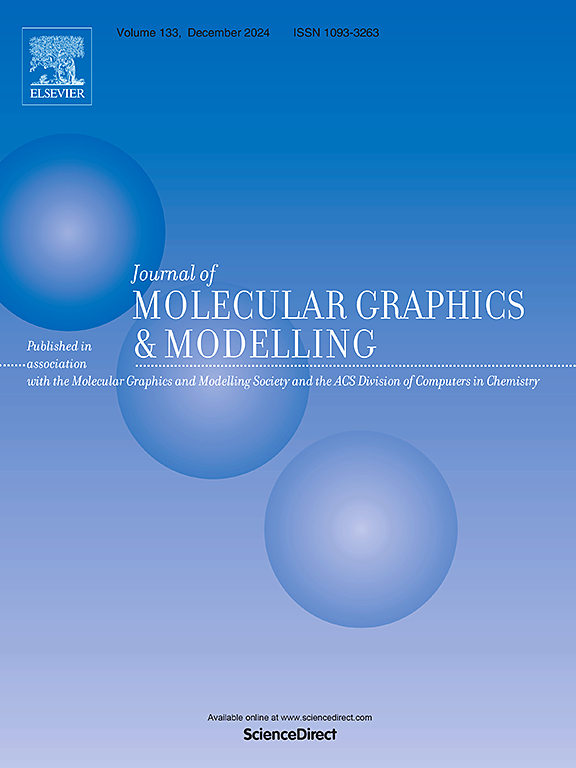利用虚拟筛选、共价对接和分子动力学模拟鉴定靶向DsbA的小共价抑制剂。
IF 3
4区 生物学
Q2 BIOCHEMICAL RESEARCH METHODS
引用次数: 0
摘要
抗菌素耐药性(AMR)是一个日益严重的全球健康威胁,突出表明迫切需要新的治疗策略。细菌抗毒剂和抗生素佐剂的发展为对抗细菌感染提供了两种有前途的策略。DsbA蛋白对细菌的毒力和耐药性至关重要,它催化细菌蛋白中二硫键的形成,使其成为新型抗生素的一个有吸引力的靶标。在这项研究中,我们采用虚拟筛选、共价对接和分子动力学模拟的方法筛选了69,579个化合物的抑制剂,以Cys30为靶点,Cys30是DsbA CXXC催化基序中关键的亲核残基。我们确定了四种与DsbA形成共价键的小分子共价抑制剂。MM/PBSA结果表明,Cov28322、Cov16876和Cov64052三个共价化合物的结合能均低于阳性对照。然而,共价结合通常具有更好的靶向特异性和持久性。这些抑制剂主要与DsbA的关键区域相互作用,包括CXXC基序和L2环,表明它们有可能破坏DsbA的催化活性。本研究为设计DsbA共价抑制剂作为抗生素佐剂提供了理论基础,为对抗细菌感染和AMR提供了一种有前景的策略。本文章由计算机程序翻译,如有差异,请以英文原文为准。

Identification of small covalent inhibitors targeting DsbA using virtual screening, covalent docking, and molecular dynamics simulations
Antimicrobial resistance (AMR) is a growing global health threat, highlighting the urgent need for new therapeutic strategies. The development of bacterial antivirulence agents and antibiotic adjuvants offers two promising strategies for combating bacterial infections. The DsbA protein is crucial for bacterial virulence and resistance, catalyzing the formation of disulfide bonds in bacterial proteins, making it an attractive target for novel antibiotics. In this study, we employed virtual screening, covalent docking, and molecular dynamics simulations to screen a library of 69,579 compounds for inhibitors targeting Cys30, a key nucleophilic residue in the CXXC catalytic motif of DsbA. We identified four small molecule covalent inhibitors that form covalent bonds with DsbA. The MM/PBSA results indicate that three covalent compounds (Cov28322, Cov16876, and Cov64052) have lower binding energies than the positive control. However, covalent binding typically offers superior target specificity and durability. These inhibitors primarily interact with key regions of DsbA, including the CXXC motif and L2 loop, suggesting their potential to disrupt DsbA's catalytic activity. This study provides a theoretical basis for designing DsbA covalent inhibitors as antibiotic adjuvants, presenting a promising strategy to combat bacterial infections and AMR.
求助全文
通过发布文献求助,成功后即可免费获取论文全文。
去求助
来源期刊

Journal of molecular graphics & modelling
生物-计算机:跨学科应用
CiteScore
5.50
自引率
6.90%
发文量
216
审稿时长
35 days
期刊介绍:
The Journal of Molecular Graphics and Modelling is devoted to the publication of papers on the uses of computers in theoretical investigations of molecular structure, function, interaction, and design. The scope of the journal includes all aspects of molecular modeling and computational chemistry, including, for instance, the study of molecular shape and properties, molecular simulations, protein and polymer engineering, drug design, materials design, structure-activity and structure-property relationships, database mining, and compound library design.
As a primary research journal, JMGM seeks to bring new knowledge to the attention of our readers. As such, submissions to the journal need to not only report results, but must draw conclusions and explore implications of the work presented. Authors are strongly encouraged to bear this in mind when preparing manuscripts. Routine applications of standard modelling approaches, providing only very limited new scientific insight, will not meet our criteria for publication. Reproducibility of reported calculations is an important issue. Wherever possible, we urge authors to enhance their papers with Supplementary Data, for example, in QSAR studies machine-readable versions of molecular datasets or in the development of new force-field parameters versions of the topology and force field parameter files. Routine applications of existing methods that do not lead to genuinely new insight will not be considered.
 求助内容:
求助内容: 应助结果提醒方式:
应助结果提醒方式:


